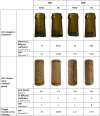Wine aging: a bottleneck story
- PMID: 31396559
- PMCID: PMC6684617
- DOI: 10.1038/s41538-019-0045-9
Wine aging: a bottleneck story
Abstract
The sporadic oxidation of white wines remains an open question, making wine shelf life a subjective debate. Through a multidisciplinary synoptic approach performed as a remarkable case study on aged bottles of white wine, this work unraveled a yet unexplored route for uncontrolled oxidation. By combining sensory evaluation, chemical and metabolomics analyses of the wine, and investigating oxygen transfer through the bottleneck/stopper, this work elucidates the importance of the glass/cork interface. It shows unambiguously that the transfer of oxygen at the interface between the cork stopper and the glass bottleneck must be considered a potentially significant contributor to oxidation state during the bottle aging, leading to a notable modification of a wine's chemical signature.
Keywords: Agriculture; Engineering; Materials science.
Conflict of interest statement
Competing interestsThe authors declare no competing interests.
Figures





References
-
- Singleton VL, Trousdale E, Zaya J. Oxidation of wines I. Young white wines periodically exposed to air. Am. J. Enol. Vitic. 1979;30:49–54.
-
- Li H, Guo A, Wang H. Mechanisms of oxidative browning of wine. Food Chem. 2008;108:1–13. doi: 10.1016/j.foodchem.2007.10.065. - DOI
-
- Oliveira CM, Ferreira ACS, De Freitas V, Silva AMS. Oxidation mechanisms occurring in wines. Food Res. Int. 2011;44:1115–1126. doi: 10.1016/j.foodres.2011.03.050. - DOI
-
- Waterhouse A. L., Frost S., Ugliano M., Cantu A. R., Currie B. L., Anderson M., Chassy A. W., Vidal S., Dieval J.-B., Aagaard O., Heymann H. Sulfur Dioxide-Oxygen Consumption Ratio Reveals Differences in Bottled Wine Oxidation. American Journal of Enology and Viticulture. 2016;67(4):449–459. doi: 10.5344/ajev.2016.16006. - DOI
LinkOut - more resources
Full Text Sources

